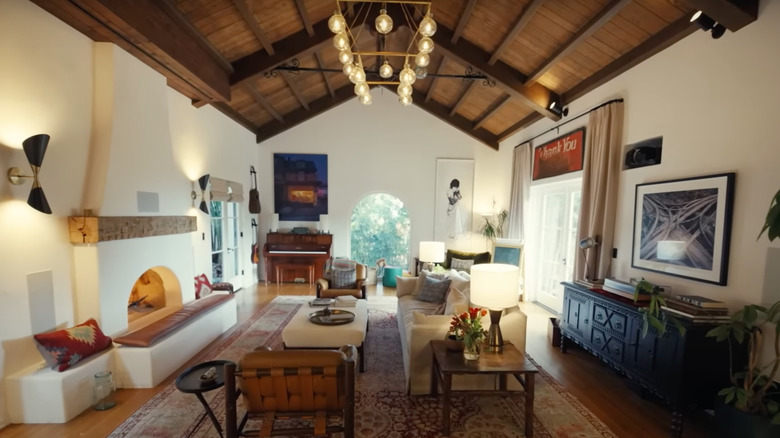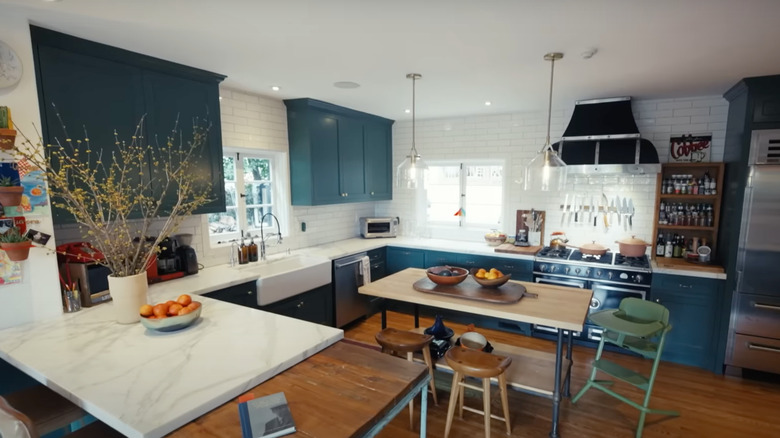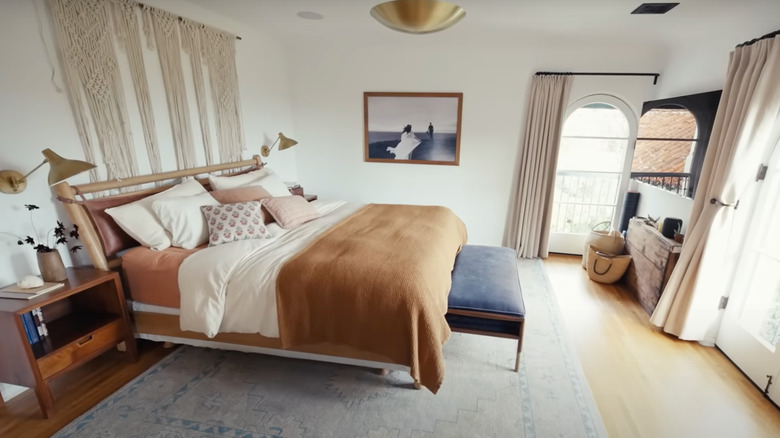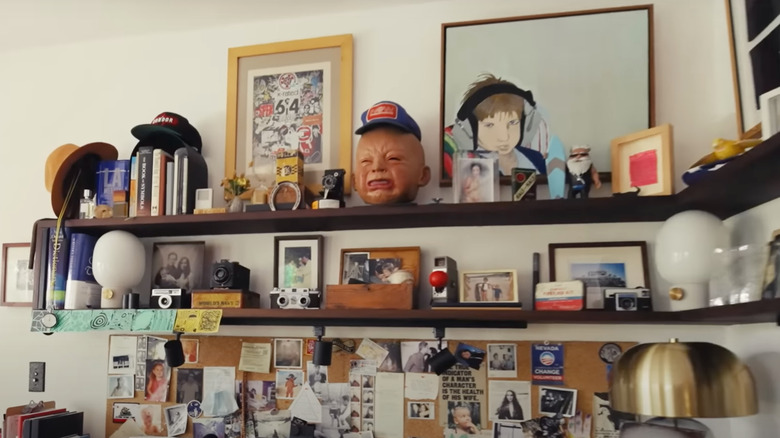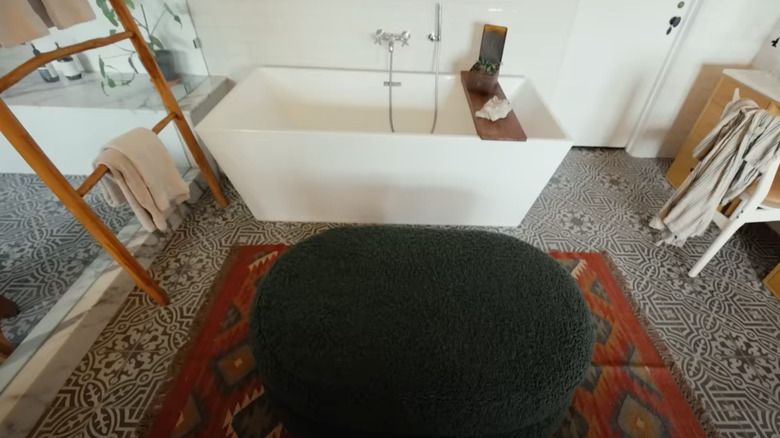How To Steal The Eclectic Look Of Troian Bellisario & Patrick J. Adams' L.A Home
Architectural Digest recently sat down with actors Troian Bellisario and Patrick J. Adams for a look inside their 1924 Spanish Colonial Revival residence. This Los Angeles stunner was originally designed by California icon Wallace Neff, and features lovely vaulted ceilings, iron details, stained glass windows, and loads of welcoming charm. This is one of the most popular styles of architecture in southern California, in no small part because it presents a bit of a blank canvas. While some homeowners over-update, gut, and entirely eliminate the original character of these incredible historical properties, Bellisario and Adams actually leaned into the existing structure. By doing so, they created a space that feels updated, warm, colorful, and practical. It fuses art deco, mid-century, and farmhouse style into — yes, you guessed it — a truly eclectic triumph, as tasteful as it is personal.
Eclectic style is regularly cited as one of the most popular types of interior design, but it's also one of the hardest to pull off. Eclecticism is hard to define, as the whole point of it is bending the rules and combining elements that you may not necessarily think work well together at first glance. But have no fear: Today, we're going to break down some of the brilliant choices and materials Bellisario and Adams used to help bring this vision to life.
Preserve ceiling details
One good rule of thumb when creating an eclectic home is to not fix things that aren't broken. Take Bellisario and Adams' living room. It's a statement piece, with two-story vaulted ceilings and a Juliet balcony that breathtakingly blends wood craftsmanship and iron details. The dark palette creates texture and depth and draws the eye upward. While they could have removed these finishes for something more minimal and airy, in this instance, not touching what already works paid off. Given the scale of the room, keeping the dark ceiling intact allows the space to feel cozy, rather than cold. By combining this existing aesthetic with warm white walls and Spanish tile, this room gains a dynamic quality that would have been lost by over-brightening the space.
Coffered ceilings are another popular style commonly found in living rooms. If you're living in a home with coffered ceilings, try and build the living room around it. If you want to honor the ceiling but add modern sensibilities, stage traditional couch and chair silhouettes, then sprinkle in the occasional contemporary lighting fixture or side table. In Bellisario and Adams' house, the furniture leans traditional and features warm hues and woods that complement the ceiling. But, in contrast, the sconces over the fireplace are mid-century, and a lot of the art is contemporary. This kind of tension is what eclectic decor is all about.
Commit to a colorful kitchen
A colorful kitchen is essential to an eclectic home. As the video tour of Bellisario and Adams' house shows, cooler colors stand out particularly well in this space. They went with Benjamin Moore's Under The Sea, an earthy, dramatic, and on-trend hue. There's a playfulness to this choice, which contrasts exceptionally well with the rich wood floors. While the white kitchen has been the dominant kitchen aesthetic for the last several years, this space makes a strong argument for bringing color into the mix. It doesn't abandon all the white kitchen elements: The countertop and white subway backsplash fit in with that aesthetic. But deep green hues transform it into something entirely different.
Combining colorful cabinets, contemporary white finishes, and rustic floors makes this kitchen another sterling example of transforming unassuming elements into something that feels unique, clean, and inviting. It's worth noting that the high chair and island are variations of the floor and cabinet colors, but not identical matches. Everything works together, but nothing is overly perfect. The key to creating this aesthetic is to be bold. Pick a cabinet color that you love, but avoid grey, black, and white. These all indicate more formal sensibilities, and that's not the objective with eclectic style. If you're bored by white countertops and backsplashes, colors like Under The Sea on kitchen cabinets tend to pair well with backsplashes that are in lighter shades of the same color, and light floors.
Add vintage bedroom hues
Light blues, warm whites, and neutrals have long dominated bedroom aesthetics. This makes sense, as these colors are calming. However, eclecticism proves that you can create relaxing spaces that are still interesting and colorful. Vintage hues can be a fantastic design choice in this regard; they evoke feelings of nostalgia and charm. Options include shades of toffee, olive, and rust. In their primary bedroom, Adams and Bellisario combine a mustard yellow bedspread, a sunset orange sheet, dusty pink pillows, and white finishes. In front of the bed is a faded navy bench with wooden legs. Initially, one would not lump these elements together. So how, then, does this all feel seamless?
Vintage hues are softer, so their differences are not as harsh to the eye. This allows warm tones like mustard and dusty pink to mesh well with brass fixtures and warm wood floors. Moreover, mustard yellow and faded navy are actually opposites on the color wheel, meaning they're complementary colors. As any art student knows, complementary colors naturally look great together. Putting them right next to each other, then, is a great idea. By accenting the bench with a light blue rug and a faded blue painting on the wall (in a warm picture frame, no less), this bedroom achieves design cohesion of the highest level.
The more tchotchkes, the merrier
An eclectic home is all about contrasting colors and styles, and keeping a space overly minimal can make your rooms feel unfinished or unbalanced. Tchotchkes are an easy way to bring your family's personal story into your home while also creating excellent design tension. Examples of tchotchkes include things like small plants, handmade pottery, trophies, and miniatures. How do you take advantage of these elements without making things feel cluttered? Adams and Bellisario's home offers a masterclass in this regard. Their office acts as a sort of personal museum, full of eccentric artwork, funky statues, old photographs, and hats. This helps the room feel lived-in, creative, and personalized. But the open shelves provide structure, which keeps it from feeling overwhelming or disorganized.
They've also made some clever and functional choices throughout other parts of the house that invite organic displays of tchotchkes. Open shelving exists in the living room for Patrick's vintage camera collection. Their kitchen features an open knife display and spice rack. The primary staircase is accented by asymmetrically displayed photographs and personal notes they've written to each other. To achieve this sort of balance, think about which of your items make sense where, and how they might contrast with existing pieces. Keep the floors clear, and start with corners, tabletops, and walls when doing initial placement.
Frame the floor with red statement rugs
Adams and Bellisario's recurring use of red statement rugs is an impressive design trick. It creates intriguing energy through contrasting rustic and classic elements. The color red, which represents excitement, power, and zeal, is used in this home the way blue is often used in other residences. The living room features a faded red Persian rug that works exceptionally well with the warm wood floors, but does not overpower the other furniture. The office features another red Persian rug distinguished by pops of blues and yellows, which tie it into the mustard sofa and fiery wall art. The primary bathroom uses a red rug. This use is particularly impressive, as it lies atop an intricately tiled floor and beneath a green seat. Even their daughter's bedroom has an expansive, blood orange statement rug in the middle of the room.
By using red as a base color for a majority of their rooms, Bellisario and Adams infuse each space with warmth and interest. Strokes of mustard, navy, black, and warm wood tones set these red rugs off perfectly, resulting in a home that feels different from many others. Where there is normally serenity, they chose creativity and warmth. It's a bold move, but opting for red rugs really can create an entirely new effect, far beyond the usual whites, neutrals, and blues that so many homes have exhausted.

